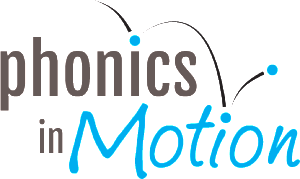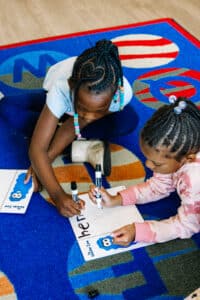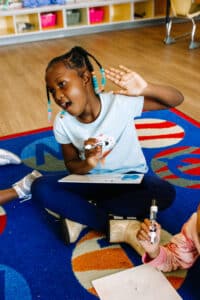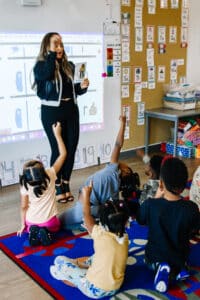Handwriting Practice Through Storytelling: Pre K – 3rd Grade
Handwriting practice remains significant in today’s modern world, where keyboards and touchscreens have become ubiquitous in our daily interactions. It might appear that the traditional art of handwriting is losing its importance, but as teachers, we must not underestimate its value. Handwriting practice goes beyond simply developing legible penmanship; it plays a pivotal role in fostering crucial cognitive and motor skills that contribute significantly to a child’s overall development.
Let’s explore what handwriting practice entails, its significance, the challenges young students face, and the best practices for effective handwriting practice. Furthermore, we will delve into Phonics in Motion’s innovative approach to teaching handwriting through multisensory stories with the Reading & Writing Monster.
Understanding Handwriting Practice
Handwriting practice involves the intentional and repetitive process of forming letters and words on paper using a pen or pencil. This foundational skill plays a crucial role in helping children learn to read and write fluently. With consistent practice, kids develop better control over their fine motor skills, hand-eye coordination, and spatial awareness, ultimately leading to improved overall dexterity.
Handwriting practice is not just about putting pen to paper; it’s about building a strong foundation for communication and self-expression. As children gain confidence in their handwriting abilities, they become more adept at conveying their thoughts and ideas. Moreover, this practice also activates areas of the brain associated with thinking, memory, and language processing, enhancing their comprehension and retention of information. By nurturing handwriting skills from an early age, we set our students up for success in their academic journey and beyond.
The Importance of Handwriting Practice
Learning handwriting has a significant impact on learning how to read. It serves as a foundational skill that complements the process of reading development and can greatly enhance a child’s overall literacy journey.
Benefit 1. Letter Identification and Formation
When children learn to write letters and words by hand, they become more familiar with the shapes and forms of each letter. This increased exposure to the visual representation of words helps them recognize and identify letters more efficiently when they encounter them in reading materials. As a result, their letter recognition skills are strengthened, which is a crucial component of early reading success.
Benefit 2. Multisensory Learning Opportunities
Moreover, the act of handwriting engages multiple sensory pathways, such as visual, motor, and tactile, creating a multisensory learning experience. This multisensory approach to learning has been shown to improve memory and information retention, which can positively impact a child’s ability to remember and recognize sight words and other essential reading strategies.
Benefit 3. Increased Understanding of the Alphabetic Principle
Additionally, as children practice forming letters and words, they develop a deeper understanding of the alphabetic principle – the connection between letters and sounds. This understanding is fundamental to phonics-based reading instruction, where children learn to decode words by associating letter sounds with their corresponding symbols.
Overall, learning handwriting provides valuable support for reading development. It helps build letter recognition, enhances memory retention, and reinforces the essential connection between letters and sounds. As teachers, fostering strong handwriting skills can play a crucial role in laying a solid foundation for our students’ reading abilities and fostering their love for literacy.
Challenges in Handwriting Practice for Young Students
While handwriting practice offers numerous benefits, it can present challenges for young students. Understanding these challenges can help educators and parents tailor their approach to make the learning process more enjoyable and effective.
Challenge 1. Physical Challenges
Let’s address the first challenge: Physical Challenges. When it comes to young children, we might encounter two main hurdles:
Hand Strength and Dexterity
Some little ones may struggle with the necessary hand strength and dexterity needed for precise letter formation. As a result, they may experience fatigue or discomfort when attempting to write for extended periods.
Hand-Eye Coordination
For beginners, coordinating hand movements with visual input can be quite a challenge. Our students must learn to control the movement of their writing utensils while simultaneously tracking their progress on paper. It takes practice and patience to master this coordination.
Challenge 2. Cognitive Challenges
Letter Formation
For our young students, remembering the correct formation of each letter in the alphabet can be quite overwhelming. They need to learn the specific strokes and proportions for each letter, and mastering this skill takes both time and practice.
Spacing and Alignment:
Maintaining consistent spacing and alignment between letters and words can be a challenge for many students. They often struggle with proper letter placement and spacing, which can lead to illegible handwriting. But fear not, with guidance and encouragement, we can help them improve and develop their handwriting skills over time.
Best Practices for Handwriting Practice
To help young students overcome the challenges associated with handwriting practice, it is essential to employ effective strategies and best practices. Here are some recommendations:
Start with Pre-Writing Activities
Before diving into formal handwriting, engage children in pre-writing activities that focus on developing fine motor skills. Drawing shapes, tracing lines, air writing, and playing with manipulative materials like clay or Play-Doh are excellent ways to prepare their little hands for writing adventures.
Provide Proper Tools and Materials
Invest in high-quality writing utensils, such as pencils with a comfortable grip, and ensure they have appropriate writing surfaces. Positioning the paper at a comfortable angle promotes proper wrist and arm alignment, making writing a more enjoyable experience.
Teach Letter Formation Step-by-Step
Break down letter formation into simple steps, emphasizing correct stroke order and letter proportion. Start by encouraging children to trace letters initially, gradually progressing to independent writing as their skills develop and confidence grows.
Practice Regularly and Gradually
Consistency is key in handwriting practice. Encourage children to practice regularly, starting with short sessions and gradually increasing the duration. This approach helps build endurance and reinforces muscle memory, making writing more fluid and natural over time.
Provide Constructive Feedback
Offer specific feedback that focuses on areas of improvement while also highlighting their achievements. Praise their efforts and progress, motivating children to continue their handwriting practice journey with enthusiasm and determination.
Phonics in Motion: Storytelling Approach to Handwriting Practice
Phonics in Motion, an innovative literacy instructional approach, takes handwriting practice to the next level by integrating it with storytelling and the use of the Reading & Writing Monster. This unique approach makes the learning experience engaging and enjoyable for young students.
Approach 1. The Reading & Writing Monster
The Reading & Writing Monster is a lovable character that guides children through the process of learning to read and write. By incorporating storytelling and visualization techniques, Phonics in Motion brings handwriting practice to life, capturing the imagination of young learners.
Approach 2: Interactive Stories for Handwriting Practice
Phonics in Motion’s interactive stories feature the Reading & Writing Monster. Throughout the stories, children are encouraged to participate actively by tracing letters and words alongside the Monster, reinforcing letter formation and improving fine motor skills. The Reading & Writing Monster lives in the Monster Zone (the left hand side of the page) and teaches children to move toward or away from the monster to teach directionality.
Approach 3: Multi-Sensory Learning Experience
The Phonics in Motion program combines visual, auditory, and kinesthetic elements, catering to diverse learning styles. By incorporating movement, sound, and tactile experiences, the program ensures a comprehensive and engaging learning journey for students.
Approach 4: Personalized and Adaptive Approach
Phonics in Motion recognizes that every child is unique, and learning progresses at an individual pace. The program offers adaptive features that adjust the difficulty level based on a child’s progress, ensuring an optimal learning experience tailored to each student’s needs.









